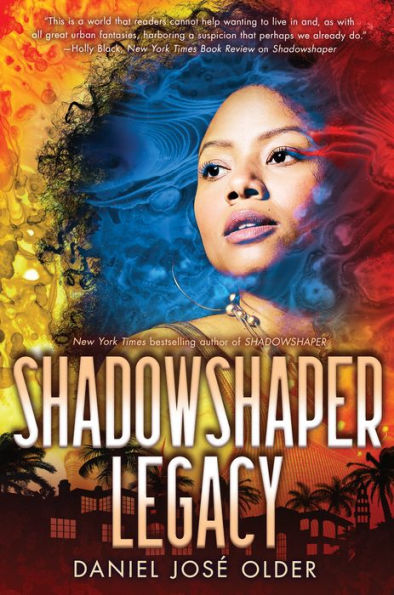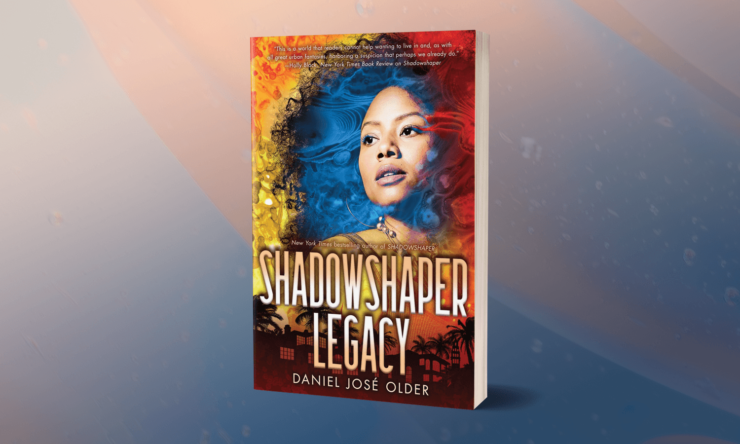If Shadowshaper, the first book in Daniel José Older’s brilliant trilogy, is about a young woman discovering her power and the second, Shadowhouse Falls, about her struggling to keep it, then the third, Shadowshaper Legacy is about taking control. Ever since she first learned about shadowshaping and the Deck of Worlds, people have tried to keep her down, to keep her from knowing just how powerful she truly is.
When Sierra Santiago became Lucera, head of the House of Shadow and Light, she became one of the most powerful figures represented in the Deck of Worlds. But keeping that power and enforcing her position prove difficult to say the least. She quickly takes out a rival leader, stripping a figurehead of her magic and eradicating a house in one fell swoop. To do that, however, Sierra had to break some Very Important Rules. Now all bets are off as the other houses consolidate under a white supremacist who wants nothing more than to steal Sierra’s power and slaughter her people. The only way to stop him is to stop, well, everything. Ending the cycle created by La Contessa generations ago ends the warfare and bloodshed today. With her friends scattered across New York City and her Puerto Rican ancestors calling her home, it will take every scrap of willpower Sierra has to save the shadowshapers and defeat the fascists.
The Shadowshaper Cypher is all about social justice, but not in the faux-woke, Black friend having, would’ve voted for Obama a third time kind of way. No, Older goes all in. Using storybook-esque interstitials that tell the story of how La Contessa created the Deck, the Houses, and the Hierophants, Older shows how white supremacy corrupts everything it touches. Exiled from Spain, La Contessa lives on Puerto Rico as a colonist. She detests her youngest daughter in part because she is the product of an affair with an islander servant, making her not Spanish but Afro-Boricua; she is la bastarda in parentage and ethnicity. La Contessa can only see magic through a colonial lens – as a means of domination and conquest – while her youngest sees it as an ally and a tool for resistance.
Buy the Book


Shadowshaper Legacy
Jump forward to today and we see this same dynamic play out with Dake and his fellow white supremacist fascists. Through Crane, white people colonized POC magic, corrupting it in the process. What was once a tool of the oppressed became a weapon of the oppressor. Sierra’s fight is bigger than who controls the Deck. She fights for freedom, for safety, and to protect her heritage and culture from colonial exploitation. By granting her POC allies shadowshaping abilities, she has leveled the playing field created by white colonizers, or more accurately leveled up her team to fight on equal terms. And as far as the colonizers are concerned, equity is an unforgivable sin.
For Dake, defeating Sierra is more than a power move. Yes, he wants the Deck because that puts him in a position of ultimate power. But he also doesn’t want Sierra – a woman of Spanish, Taíno, and African descent – to have that power. More than that, he thinks she doesn’t deserve it because she’s a woman, because she’s a person of color, and because she’s a woman of color. Any woman of color who spends any time on Twitter will immediately recognize the particular strain of bro-ish awfulness that Dake represents, a virulent combination of racist and far-right fascism. Older doesn’t hesitate to call him and his followers nazis, with a lowercase “n” that denies them the status and unity that comes from a proper name. That lowercase “n” is in its own small way an act of resistance, an act of disrespect, a defiant rejection of everything they espouse.
The other big theme of the series is, as Shadowshaper Legacy demonstrates, heritage. The creation of the Houses and the Deck, shadowshaping, even the overarching magical conflicts, it all comes down to family. Sierra is both cursed and saved by her ancestors, an experience common with people of color who live under the yolk of white supremacy. She holds both pasts in her memory, that of the pain of the exploited and those gleefully doing the exploiting. The only way to save her people is to learn to negotiate that contradiction, but it’s also the only way her family can heal. To be at war with one’s ancestors is to never know peace. Sierra must excavate her family history in Shadowshaper Legacy. She must understand the beginning to dictate the end.
With each entry in the Shadowshaper Cypher, Older’s attacks on racism, sexism, police brutality, white supremacy, colonialism, and toxic masculinity get sharper and harsher. Shadowshaper Legacy is the pinnacle of this series-long treatise, not just because it is the conclusion of the trilogy (and the two novellas) but because it distills everything down to a fine point. Sierra’s fight gets harder and Older’s critiques less forgiving.
On a structural level, it’s obvious Older is a master craftsman. He makes juggling multiple POVs look easy, using each character to slow down or speed up the pacing all while not overwhelming the reader. Every character feels new and realistic with their own personality quirks and interior lives. Older manages to exactly capture how teens actually sound as opposed to how most young adult authors think teenagers sound. “Impressive” doesn’t even begin to cover it.
In my review of the first two books, Shadowshaper and Shadowhouse Fall, I talked about how I often recommended the series to my library patrons. With Shadowshaper Legacy as good as it is, I know this series will remain a staple on my recommendation rotation for teens and adults alike. Shadowshaper Legacy is a wholly satisfying conclusion to a powerful series.
Shadowshaper Legacy is available from Scholastic.
Alex Brown is a teen services librarian by day, local historian by night, author and writer by passion, and an ace/aro Black woman all the time. Keep up with her on Twitter and Insta, or follow along with her reading adventures on her blog.











Great review, Alex! I agree this is such an amazing series. I’m glad to hear it finishes strong. Can’t wait to read it.